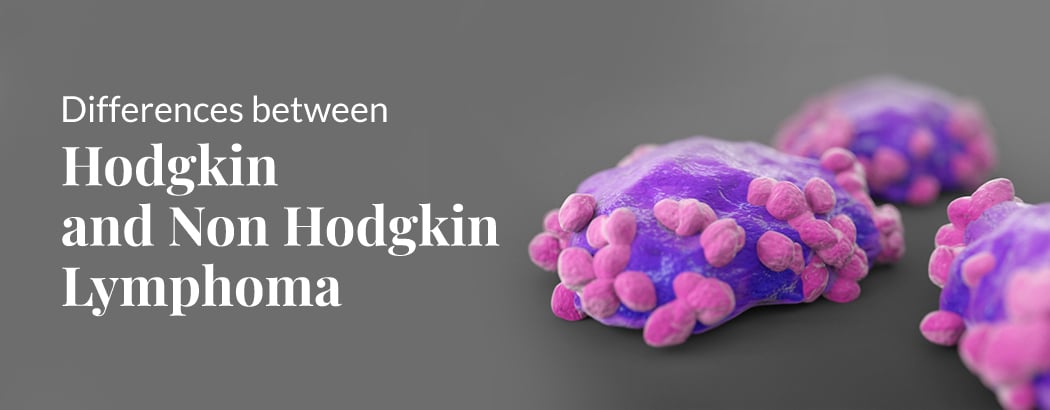Difference between Hodgkin and non Hodgkin lymphoma
December 16, 2023

Difference between Hodgkin and non Hodgkin lymphoma
Hodgkin lymphoma and non-Hodgkin lymphoma are easily confused due to their similar names. Though some distinctions may impact available treatments, they are malignancies that negatively impact and spread through the body’s lymphatic system.
Contents
- Lymphoma
- Presence of lymphocytes as a differentiator between Hodgkin and non-Hodgkin lymphoma
- Age as a differentiator
- Occurrence as a differentiator
- Survival Rate as a differentiator
- Types of Treatment as a differentiator
- Location of lymphoma as a differentiator
- Gender as a differentiator
- Family History as a differentiator
- Virus as a differentiator
- Symptoms as a differentiator
- Conclusion
Lymphoma
One type of cancer that affects lymphocytes is called lymphoma. There are numerous lymphoma subtypes. The lymphocyte is an essential component of the body’s immune system that combats germs. There are two types of lymphomas:
- Hodgkin’s lymphoma
- Non-Hodgkin’s lymphoma
The lymphatic system, the body’s network of lymph nodes that release B lymphocytes, which are white blood cells, is the source of both cancers.
Presence of Lymphocytes as a differentiator between Hodgkin and non-Hodgkin lymphoma
The particular lymphocytes that each type of lymphoma involves is the primary difference between non-Hodgkin’s and Hodgkin’s lymphoma.
Examining the cancer cells under a microscope will reveal the differences between Hodgkin’s and non-Hodgkin’s lymphoma. Hodgkin’s lymphoma is identified if a particular kind of cell known as a Reed-Sternberg cell is observed. An absence of the Reed-Sternberg cell indicates that the lymphoma is non-Hodgkin’s.
Age as a differentiator between Hodgkin and non-Hodgkin lymphoma
Age of the patients diagnosed with either form of the disease can be used as a difference between Hodgkin and non-Hodgkin lymphoma.
Hodgkin lymphoma: Patients with this illness are typically 39 years old.
Non-Hodgkin lymphoma: Patients with non-Hodgkin lymphoma are typically 67 years old when diagnosed.
Occurrence as a differentiator between Hodgkin and non-Hodgkin lymphoma
Hodgkin lymphoma: This disease is rare, accounting for about 0.4 percent of all new cancers diagnosed.
Non-Hodgkin lymphoma: This is the seventh-most diagnosed cancer.
Survival Rate as a differentiator between Hodgkin and non-Hodgkin lymphoma
The specific circumstances of each patient determine the survival data as a difference between Hodgkin and non-Hodgkin lymphoma; however, in general, the five-year relative survival rate for Hodgkin lymphoma is higher than that of non-Hodgkin lymphoma. The fact that non-Hodgkin lymphoma is frequently discovered when the cancer has progressed could be one factor or more.
Types of lymphoma as a differentiator between Hodgkin and non-Hodgkin lymphoma
Hodgkin lymphoma: This cancer can be classified into four primary forms. Nodular sclerosis and mixed cellularity are the most prevalent types, making up nearly 90% of all diagnoses.
Non-Hodgkin lymphoma: This cancer has over 30 different types and countless subtypes. About 30% of cases are diffuse large B-cell lymphoma (DLBCL), which is the most prevalent type.
Types of Treatment as a differentiator between Hodgkin and non-Hodgkin lymphoma
Hodgkin lymphoma: Chemotherapy and radiation therapy, which can be administered separately or in combination, are the most widely used treatments for Hodgkin lymphoma. Certain patients may require additional treatments, such as immunotherapy or allogeneic stem cell transplantation, based on their specific needs and diagnosis.
Non-Hodgkin lymphoma: Treatment options for non-Hodgkin lymphoma may also include immunotherapy, chemotherapy, radiation therapy, and stem cell transplants. For non-Hodgkin lymphoma, the care team may also recommend surgery or targeted therapy drugs. CAR T-cell therapy is one form of immunotherapy that has been authorized in the past ten years for the treatment of non-Hodgkin lymphoma.
Location of lymphoma as a differentiator between Hodgkin and non-Hodgkin lymphoma
Hodgkin lymphoma: This lymphoma is more likely to appear in lymph nodes in the chest, neck, or underarms.
Non-Hodgkin lymphoma: This lymphoma is more likely to appear in lymph nodes throughout the body or in organs.
Gender as a differentiator between Hodgkin and non-Hodgkin lymphoma
Hodgkin lymphoma: Hodgkin’s lymphoma occurs slightly more often in men than in women.
Non-Hodgkin lymphoma: Men are more likely than women to develop non-Hodgkin’s lymphoma overall, but certain subtypes are more common in the female population.
Family History as a differentiator between Hodgkin and Non-Hodgkin lymphoma
Hodgkin lymphoma: The likelihood of developing Hodgkin’s lymphoma in siblings of young individuals with the disease is very high. The risk for identical twins is extremely high.
Non-Hodgkin lymphoma: The risk of getting non-Hodgkin’s lymphoma is increased if you have a sibling, parent, or child who has the disease.
Virus as a differentiator between Hodgkin and non-Hodgkin lymphoma
Hodgkin lymphoma: Individuals with a history of mononucleosis caused by the Epstein-Barr virus are more susceptible to Hodgkin’s lymphoma.
Non-Hodgkin lymphoma: Burkitt’s lymphoma, a specific kind of non-Hodgkin’s lymphoma that primarily affects African children, has also been connected to the Epstein-Barr virus.
Other viruses linked to the development of some specific types of non-Hodgkin’s lymphoma include:
- Chronic Hepatitis C
- HIV
- Human T-cell lymphotropic virus
- Human herpesvirus
Symptoms as a differentiator between Hodgkin and non-Hodgkin lymphoma
Both forms of lymphoma are characterized by symptoms such as fever, chills, fatigue, coughing or difficulty breathing, shortness of breath, lymph node swelling, and inadvertent weight loss. A few symptoms, though, are unique to each type of cancer.
Hodgkin lymphoma: Hodgkin lymphoma may also result in itching skin or appetite loss
Non-Hodgkin lymphoma: Symptoms specific to non-Hodgkin lymphoma can include:
- Early satiety after eating a small amount of food
- Easy bruising or bleeding
- Severe or frequent infections
- Swollen belly
Conclusion
The two primary forms of lymphomas are non-Hodgkin lymphoma and Hodgkin lymphoma. non-Hodgkin lymphoma (NHL) and Hodgkin lymphoma (HL) can easily be confused. Notwithstanding their similar names, these two illnesses are very different from one another. Although your immune system plays a role in the development of both cancers, the main difference between Hodgkin and non-Hodgkin lymphoma is the presence of a particular aberrant cell in the biopsy. Despite the relative rarity of both types of lymphoma, most patients have a good prognosis, especially with medical professionals’ support.
Frequently Asked Questions
1. Which is more aggressive, Hodgkin or non-Hodgkin lymphoma?
non-Hodgkin lymphoma tends to be more aggressive. Slow-growing forms of non-Hodgkin lymphoma are currently not curable. Since there are more than 60 subtypes of non-Hodgkin lymphoma, generalizations about the disease are more difficult. The prognosis differs greatly based on the particular subtype.
2. Which form of lymphoma is more common?
Hodgkin’s lymphoma is rare but less common. This disease is rare, accounting for about 0.4% of all new cancers diagnosed while non-Hodgkin lymphoma is also rare but more common and there are more than 60 distinct types of non-Hodgkin lymphoma.
3. Do the symptoms of non-Hodgkin’s lymphoma and Hodgkin’s lymphoma differ or are they similar?
Both forms of lymphoma can have comparable symptoms. These could change based on the specific type of lymphoma you have and the extent of the illness. Some patients might not exhibit any symptoms at the time of diagnosis. If the disease has spread to other vital organs, other persons may experience potentially fatal complications.








